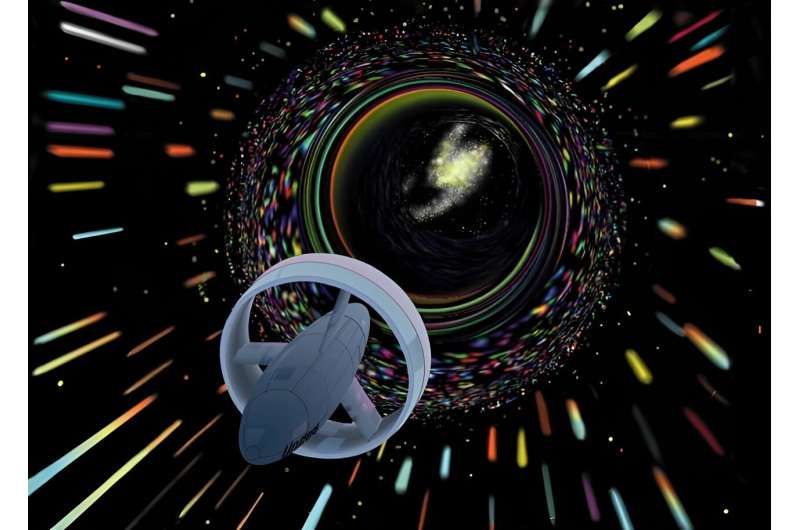This artist's illustration shows a spacecraft using an Alcubierre Warp Drive to warp space and 'travel' faster than light. Credit: NASA
Will future humans use warp drives to explore the cosmos? We're in no position to eliminate the possibility. But if our distant descendants ever do, it won't involve dilithium crystals, and Scottish accents will have evaporated into history by then.
Warp drives have their roots in one of the most popular science fiction franchises ever, but they do have a scientific basis. A new paper examines the science behind them and asks if a warp drive containment failure would emit detectable gravitational waves.
The paper is titled "What no one has seen before: gravitational waveforms from warp drive collapse," and it is posted to the arXiv preprint server. The authors are Katy Clough, Tim Dietrich, and Sebastian Khan, physicists from institutions in the U.K. and Germany.
There's room for warp drives in General Relativity, and Mexican physicist Miguel Alcubierre described how they could theoretically work in 1994. He's well-known in space and physics circles for his Alcubierre Drive.
Everyone knows that no object can travel faster than the speed of light. But warp drives may offer a workaround. By warping spacetime itself, a spacecraft with a warp drive wouldn't be breaking the faster-than-light (FTL) rule.
"Despite originating in science fiction, warp drives have a concrete description in general relativity, with Alcubierre first proposing a spacetime metric that supported faster-than-light travel," the authors write.
There are clear scientific barriers to actually making a warp drive. But it's possible to simulate how one would work and how they may be detectable via gravitational waves in the event of a failure.
Warp drives distort spacetime itself, just like binary mergers of compact objects like black holes and neutron stars. It's theoretically possible that they emit a gravitational wave signal in the same vein as mergers.
"To search for such signals and to correctly identify them in the measured data, it is important to understand their phenomenology and properties," the authors explain.
It begins with understanding how warp drives might work, and for that, we have to delve deeply into physics.
"The principal idea behind a warp drive is that instead of exceeding the speed of light directly in a local reference frame, which would violate Lorentz invariance, a 'warp bubble' could traverse distances faster than the speed of light (as measured by some distant observer) by contracting spacetime in front of it and expanding spacetime behind it," the paper states.
The first barrier is that warp drives require a Null Energy Condition (NEC). Physics states that a region of space cannot have a negative energy density. There are theoretical workarounds for that, but for now, none of them are practical.
"Other issues with the warp drive metric include the potential for closed time-like curves and, from a more practical perspective, the difficulties for those in the ship in controlling and deactivating the bubble," the authors explain.
This is because there would be no way for the crew to send signals to the front of the ship. It's difficult for events inside the bubble to influence events outside the warp bubble, as an earlier paper explains.
More information: Katy Clough et al, What no one has seen before: gravitational waveforms from warp drive collapse, arXiv (2024). DOI: 10.48550/arxiv.2406.02466
Journal information: arXiv
Provided by Universe Today
























